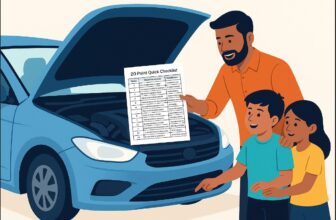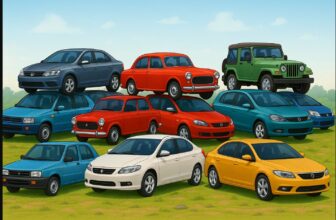When you own a car in India, you quickly realize it’s more than just a machine that takes you from one place to another. Dealers, mechanics, and even friends often use terms like “BHP,” “torque,” or “ABS,” and if you don’t know what they mean, the conversation can feel confusing. These technical words directly affect how your car performs, how safe it is on the road, and how much you spend on maintenance.
Understanding the basics isn’t just for enthusiasts. If you know the difference between CC and power-to-weight ratio, or why ABS and ESC are not the same, you can make better choices while buying, driving, or servicing your car. In India, where driving conditions vary from highways to pothole-ridden city roads, this knowledge makes a practical difference in everyday ownership.
This list breaks down 30 technical car terms in simple language, with examples and context relevant to drivers. By the end, you’ll not only understand the jargon but also know how each term impacts your driving experience.
Engine and Powertrain: How Cars Generate Power
1. Cubic Capacity (CC)
Cubic capacity measures the engine size in cubic centimeters. A higher CC generally means more power, but it can also reduce fuel efficiency. In India, entry-level cars start from about 800cc, while SUVs often go above 2000cc.
For example, Maruti Alto with 796cc delivers high mileage but modest power, while Mahindra Scorpio with a 2000cc diesel engine offers more pulling strength. CC is also a key factor in road tax slabs in some states.
2. BHP (Brake Horsepower)
BHP indicates the power an engine produces before drivetrain losses. It affects acceleration and top speed. For example, a hatchback with 80 BHP feels very different from an SUV with 150 BHP.
Buyers often confuse BHP with overall performance, but weight and torque also play a role. That’s why some smaller turbo cars with lower BHP still feel more responsive than bigger naturally aspirated ones.
3. Torque
Torque is the pulling force produced by the engine, measured in Newton-metres (Nm). High torque is useful for overtaking, carrying loads, and driving in hilly areas. Diesel cars usually produce more torque than petrol cars at lower RPM.
In India, where many cities have steep flyovers and highways require quick overtakes, torque is often more relevant than BHP. Trucks and SUVs emphasize torque for load-carrying ability.
4. RPM (Revolutions Per Minute)
RPM shows how many times the engine crankshaft rotates in a minute. Higher RPM produces more power, but also increases fuel consumption. Petrol engines usually rev higher, while diesel engines deliver power at lower RPM.
Understanding RPM bands helps drivers shift gears efficiently. Staying in the “power band” gives better pickup, while cruising at lower RPM improves mileage.
5. Turbocharger
A turbocharger forces extra air into the engine to increase power without increasing engine size. Many small Indian cars use turbos to balance fuel efficiency with performance.
Turbocharged engines deliver more punch, but they can develop turbo-lag, a delay in response. In city traffic, this lag is noticeable, but on highways, it provides a clear advantage.
6. Naturally Aspirated Engine
This type of engine relies only on atmospheric pressure to draw in air. While less powerful than a turbocharged engine, it has simpler maintenance and smoother power delivery.
Cars like the Toyota Innova have long used naturally aspirated engines for their reliability. Though less thrilling, they are valued in India for long-term durability.
7. Power-to-Weight Ratio
This is the ratio of engine power (BHP) to vehicle weight. A lighter car with modest power can feel faster than a heavier car with higher power. This metric is crucial when comparing performance across different car segments.
For instance, compact cars like the Swift feel peppier than heavier sedans with similar BHP. This is why enthusiasts often look at power-to-weight ratio before considering raw BHP.
Transmission and Drivetrain: How Cars Deliver Power to Wheels
8. Manual Transmission (MT)
The traditional gearbox with a clutch pedal and gearstick. Still popular in budget cars due to affordability and fuel efficiency.
Manuals are also cheaper to maintain. In rural India, where mechanics may not be trained on automatics, manual cars are easier to repair.
9. Automatic Transmission (AT)
Includes types like torque converter AT, CVT, AMT, and DCT. Automatics are gaining popularity in Indian cities due to heavy traffic conditions.
Each type behaves differently: AMTs are affordable but jerky, CVTs are smooth but noisy, while DCTs are sporty but expensive. Choosing the right one depends on budget and driving style.
10. Clutch
The clutch connects and disconnects the engine from the gearbox. In India’s stop-go traffic, clutches wear out faster and need periodic replacement.
Heavy clutch pedals are a frequent complaint in budget cars. Many owners in cities prefer automatics simply to avoid constant clutch use.
11. Differential
A mechanical device that lets wheels rotate at different speeds when turning. Essential for stability during cornering.
Without a differential, cars would skid or drag tyres in every turn. SUVs often use advanced differentials for better traction on rough terrain.
12. Front-Wheel Drive (FWD)
The most common drivetrain in India. It improves fuel economy and space but may lack traction on rough terrain.
Because the engine and drive components are packed in the front, FWD cars are cheaper to manufacture. That’s why nearly all hatchbacks and compact sedans in India are FWD.
13. Rear-Wheel Drive (RWD)
Preferred in performance cars and luxury sedans. It provides better handling but is less fuel-efficient in city driving.
Brands like BMW and Mercedes keep RWD in India for driving dynamics. Taxi cars and smaller vehicles rarely use RWD today.
14. All-Wheel Drive (AWD) / 4×4
Power is distributed to all wheels for better grip. Useful in SUVs, especially for off-road trips in hilly states like Himachal or Uttarakhand.
Some SUVs offer part-time 4×4 modes, where drivers engage it only when needed. This balances fuel efficiency with off-road capability.
Safety and Control: Features That Protect You
15. ABS (Anti-lock Braking System)
Prevents wheels from locking during hard braking, reducing skidding risk. ABS has been mandatory in all new cars sold in India since 2019.
ABS is particularly helpful on wet or sandy roads, common during Indian monsoons. It reduces stopping distance and keeps steering functional.
16. EBD (Electronic Brakeforce Distribution)
Works with ABS to distribute braking power across all wheels for better stability. Found even in budget hatchbacks today.
For example, if the rear of the car is heavily loaded, EBD ensures enough braking power goes to rear wheels to maintain balance.
17. ESC (Electronic Stability Control)
Detects loss of control and applies brakes selectively to stabilize the car. This feature is being made mandatory in higher-end models in India.
ESC is useful during sudden lane changes on highways. Though rarely noticed, it can prevent dangerous skids.
18. Traction Control System (TCS)
Prevents wheel spin on slippery surfaces like wet roads. Mostly available in premium cars and SUVs.
TCS is handy on rainy days or when starting on gravel. While not common in budget models, it’s a safety standard abroad.
19. Crumple Zones
Parts of the car body designed to deform and absorb energy in a crash. Cars with well-designed crumple zones protect passengers better.
This concept is still under-discussed in India, where many buyers focus only on mileage. Crash tests highlight why crumple zones matter.
20. Airbags
Safety cushions that deploy in collisions. Indian regulations now require dual airbags as standard, and there is a push toward six airbags.
Airbags alone are not enough. They work best with seatbelts. Many accidents in India highlight misuse when passengers don’t wear belts.
21. NCAP Safety Ratings
NCAP stands for New Car Assessment Program. Global NCAP and Bharat NCAP test Indian cars for crash safety. These ratings are becoming an important factor for buyers.
For instance, Tata and Mahindra cars gained popularity after good NCAP scores. Poor ratings can damage brand reputation.
Electrical and Engine Management: The Car’s Nervous System
22. ECU (Engine Control Unit)
The ECU is the “brain” of the car that controls fuel injection, ignition timing, and emissions. A malfunctioning ECU can affect performance and mileage.
Modern ECUs can also be “remapped” to increase power or efficiency, though this may void warranty.
23. Fuel Injection (FI)
Modern cars use electronic fuel injection to improve efficiency and reduce emissions. Carburetors have been phased out in India.
FI systems adjust fuel delivery depending on throttle input, temperature, and altitude, important in India’s varied terrains.
24. Alternator
This device charges the battery while the engine runs. If it fails, the car will eventually stop once the battery drains.
Alternator issues often show up as dimming headlights or dead batteries. Replacement costs are significant, so timely checks are essential.
25. OBD (On-Board Diagnostics) Port
A universal port that mechanics use to scan and diagnose problems. OBD-II is standard in all BS6-compliant cars in India.
Even cheap OBD scanners are now sold online. Many owners use them to monitor errors at home before visiting a workshop.
Tyres and Suspension: Contact with the Road
26. Ground Clearance
The distance between the lowest point of the car and the road. In India, higher ground clearance is preferred to tackle speed breakers and potholes.
Sedans with low clearance often scrape speed breakers, making SUVs with higher clearance more popular.
27. Wheelbase
The distance between the front and rear wheels. A longer wheelbase improves stability but may reduce turning ability in tight spaces.
For instance, long-wheelbase cars like SUVs are great on highways but tougher to park in crowded city lanes.
28. Suspension System
Suspension includes springs and dampers that absorb road shocks. Types like MacPherson strut or torsion beam are common in Indian cars.
Cars with soft suspension offer comfort, but stiffer suspension improves handling. Indian buyers often prefer comfort for rough city roads.
29. Tyre Pressure (PSI)
Tyres need proper inflation for safety, mileage, and durability. Under-inflated tyres can reduce efficiency and increase wear.
Checking tyre pressure every two weeks is essential in India due to varying road conditions and heat.
30. TPMS (Tyre Pressure Monitoring System)
A feature that alerts drivers when tyre pressure is too low. Increasingly seen in mid-range and premium Indian cars.
Some cars use direct sensors in each tyre, while others use ABS-based systems. Both reduce the risk of blowouts on highways.
Conclusion: Car Technical Terms You Should Know
Cars today are packed with more technology and safety features than ever before. But unless you understand the key technical terms, it’s easy to overlook details that affect performance, efficiency, and long-term reliability. Knowing what CC, BHP, torque, or ABS really mean gives you an edge when dealing with mechanics, choosing between models, or even explaining features to family members.
In India, where driving conditions range from expressways to narrow city lanes, and where safety standards are rapidly improving, this knowledge is not optional, it’s part of being a responsible car owner. By familiarizing yourself with these 30 terms, you can make smarter purchase decisions, maintain your car better, and stay confident behind the wheel.





